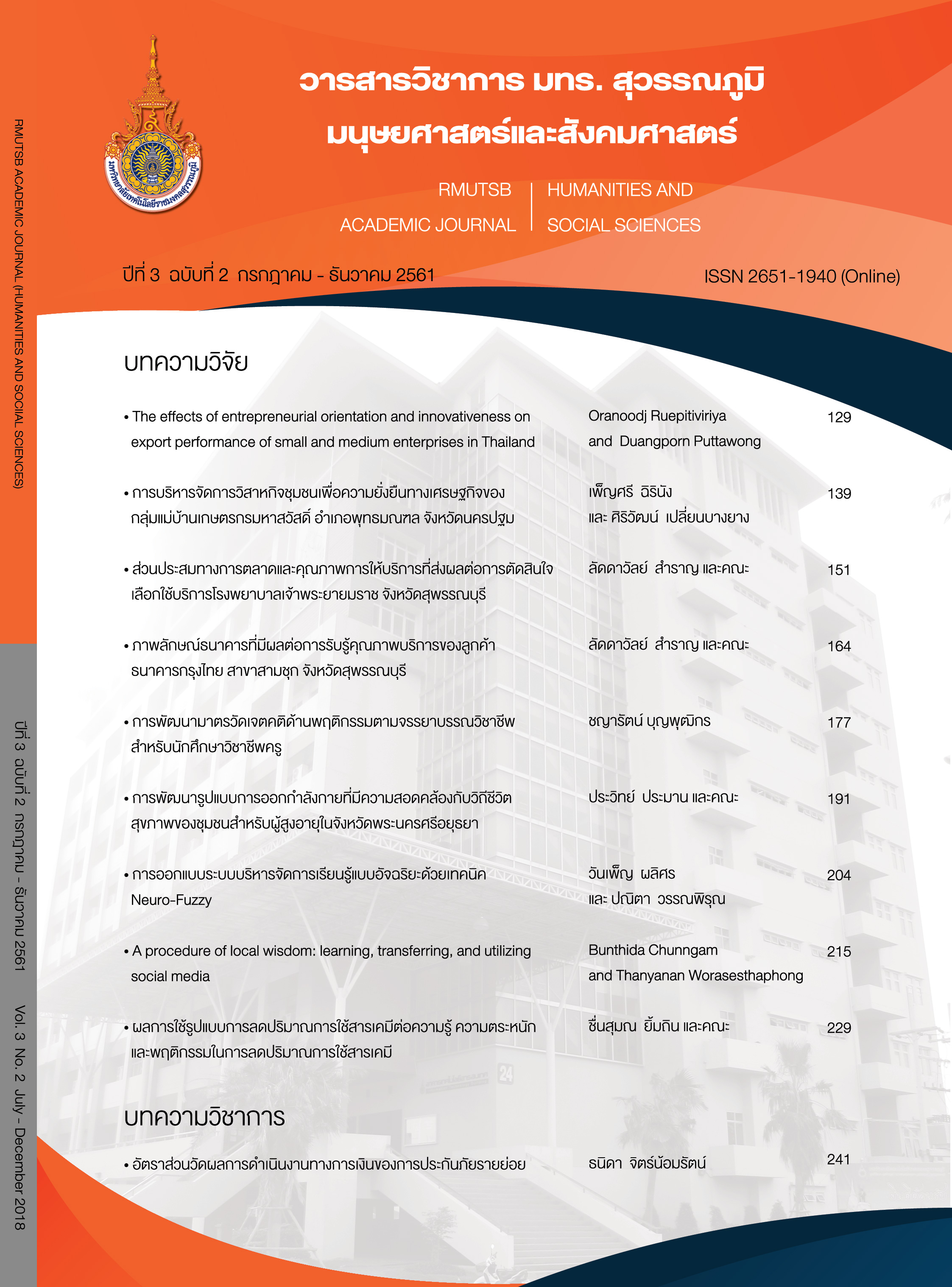The effects of entrepreneurial orientation and innovativeness on export performance of small and medium enterprises in Thailand
Main Article Content
บทคัดย่อ
-
Article Details
รูปแบบการอ้างอิง
Ruepitiviriya, O., & Puttawong, D. (2018). The effects of entrepreneurial orientation and innovativeness on export performance of small and medium enterprises in Thailand. วารสารวิชาการ มทร.สุวรรณภูมิ ฉบับมนุษยศาสตร์และสังคมศาสตร์, 3(2), 129–138. สืบค้น จาก https://so05.tci-thaijo.org/index.php/rmutsb-hs/article/view/136508
ประเภทบทความ
บทความวิจัย
เอกสารอ้างอิง
Al-Swidi, A. K., & Mahmood, R. (2011). How does organizational culture shape the relationship between entrepreneurial orientation and the organizational performance of banks? European Journal of Social Sciences, 20(1), 28-46.
Carman, J. M. (2000). Patient perceptions of service quality: combining the dimensions. Journal of services marketing, 14(4), 337-352.
Costello, A. B., & Osborne, J. W. (2005). Best practices in exploratory factor analysis: Four recommendations for getting the most from your analysis. Practical assessment, research & evaluation, 10(7), 1-9.
Cronbach, L. J. (1951). Coefficient alpha and the internal structure of tests. psychometrika, 16(3), 297-334.
Curran, P. J., West, S. G., & Finch, J. F. (1996). The robustness of test statistics to nonnormality and specification error in confirmatory factor analysis. Psychological methods, 1(1), 16.
Drucker, P. F. (1994). The theory of the business. Harvard business review, 72(5), 95-104.
Guan, J., & Ma, N. (2003). Innovative capability and export performance of Chinese firms. Technovation, 23(9), 737-747.
Hair, J. F. J., Black, W., Babin, B., Anderson, R., & Tatham, R. L. (2006). Mutivariate data analysis. Upper Saddle River: Peasons Prentice Hall.
Kanungo, S., Duda, S., & Srinivas, Y. (1999). A structured model for evaluating information systems effectiveness. systems Research and Behavioral Science, 16(6), 495-518.
Kline, R. B. (2011). Principles and practice of structural equation modeling. New York: Guilford Press.
Krauss, S. I., Frese, M., Friedrich, C., & Unger, J. M. (2005). Entrepreneurial orientation: A psychological model of success among southern African small business owners. European Journal of Work and Organizational Psychology, 14(3), 315-344.
Miller, K. D., & Bromiley, P. (1990). Strategic risk and corporate performance: An analysis of alternative risk measures. Academy of Management journal, 33(4), 756-779.
OSMEP. (2018). The trends of the export, import and the growth rate of the SMEs, 2012-2016. Retrieved 25 July 2018, from https://www.sme.go.th/eng/
Sher, P. J., & Yang, P. Y. (2005). The effects of innovative capabilities and R&D clustering on firm performance: the evidence of Taiwan's semiconductor industry. Technovation, 25(1), 33-43.
Wang, C. L. (2008). Entrepreneurial orientation, learning orientation, and firm performance. Entrepreneurship theory and practice, 32(4), 635-657.
Wiklund, J. (1999). The sustainability of the entrepreneurial orientation-performance relationship. Entrepreneurship Theory and Practice, 24(1), 37-48.
Zahra, S. A. (1991). Predictors and financial outcomes of corporate entrepreneurship: An exploratory study. Journal of business venturing, 6(4), 259-285.
Zahra, S. A., & Covin, J. G. (1995). Contextual influences on the corporate entrepreneurship-performance relationship: A longitudinal analysis. Journal of business venturing, 10(1), 43-58.
Zhao, F. (2001). Managing innovation and quality of collaborative R&D. In Proceedings of 5th International & 8th National Research Conference (pp.1-13). Melbourne Australia.
Zhou, L., Wu, W. p., & Luo, X. (2007). Internationalization and the performance of born-global SMEs: the mediating role of social networks. Journal of international business studies, 38(4), 673-690.
Carman, J. M. (2000). Patient perceptions of service quality: combining the dimensions. Journal of services marketing, 14(4), 337-352.
Costello, A. B., & Osborne, J. W. (2005). Best practices in exploratory factor analysis: Four recommendations for getting the most from your analysis. Practical assessment, research & evaluation, 10(7), 1-9.
Cronbach, L. J. (1951). Coefficient alpha and the internal structure of tests. psychometrika, 16(3), 297-334.
Curran, P. J., West, S. G., & Finch, J. F. (1996). The robustness of test statistics to nonnormality and specification error in confirmatory factor analysis. Psychological methods, 1(1), 16.
Drucker, P. F. (1994). The theory of the business. Harvard business review, 72(5), 95-104.
Guan, J., & Ma, N. (2003). Innovative capability and export performance of Chinese firms. Technovation, 23(9), 737-747.
Hair, J. F. J., Black, W., Babin, B., Anderson, R., & Tatham, R. L. (2006). Mutivariate data analysis. Upper Saddle River: Peasons Prentice Hall.
Kanungo, S., Duda, S., & Srinivas, Y. (1999). A structured model for evaluating information systems effectiveness. systems Research and Behavioral Science, 16(6), 495-518.
Kline, R. B. (2011). Principles and practice of structural equation modeling. New York: Guilford Press.
Krauss, S. I., Frese, M., Friedrich, C., & Unger, J. M. (2005). Entrepreneurial orientation: A psychological model of success among southern African small business owners. European Journal of Work and Organizational Psychology, 14(3), 315-344.
Miller, K. D., & Bromiley, P. (1990). Strategic risk and corporate performance: An analysis of alternative risk measures. Academy of Management journal, 33(4), 756-779.
OSMEP. (2018). The trends of the export, import and the growth rate of the SMEs, 2012-2016. Retrieved 25 July 2018, from https://www.sme.go.th/eng/
Sher, P. J., & Yang, P. Y. (2005). The effects of innovative capabilities and R&D clustering on firm performance: the evidence of Taiwan's semiconductor industry. Technovation, 25(1), 33-43.
Wang, C. L. (2008). Entrepreneurial orientation, learning orientation, and firm performance. Entrepreneurship theory and practice, 32(4), 635-657.
Wiklund, J. (1999). The sustainability of the entrepreneurial orientation-performance relationship. Entrepreneurship Theory and Practice, 24(1), 37-48.
Zahra, S. A. (1991). Predictors and financial outcomes of corporate entrepreneurship: An exploratory study. Journal of business venturing, 6(4), 259-285.
Zahra, S. A., & Covin, J. G. (1995). Contextual influences on the corporate entrepreneurship-performance relationship: A longitudinal analysis. Journal of business venturing, 10(1), 43-58.
Zhao, F. (2001). Managing innovation and quality of collaborative R&D. In Proceedings of 5th International & 8th National Research Conference (pp.1-13). Melbourne Australia.
Zhou, L., Wu, W. p., & Luo, X. (2007). Internationalization and the performance of born-global SMEs: the mediating role of social networks. Journal of international business studies, 38(4), 673-690.


